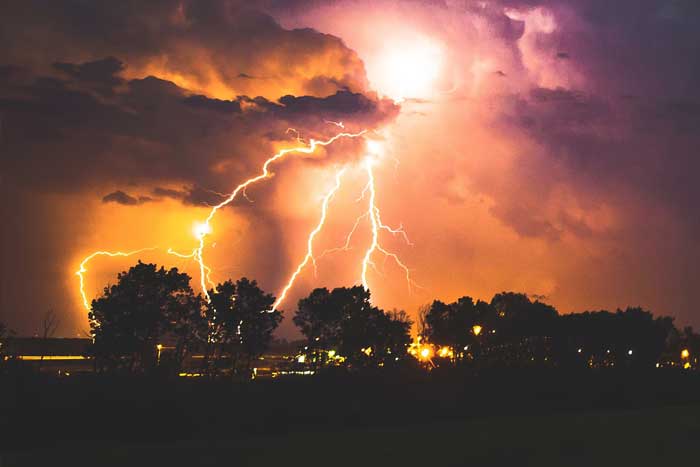Electrical storms can be amazing to watch. It doesn’t matter whether it’s a sheet or fork lightning, it will illuminate the sky and send a chill through your body. There are plenty of electrical storms in Australia every year which are worth watching.

However, it all changes when the storm gets closer to home. This is when you start to realize that the average lightning flash contains 300 million volts and as much as30,000 amps. That is significantly more than the 230 volts you get at a domestic socket.
The Damage Done By Lightning
When lightning hits your home it will course through all the materials, including any electrical item that you have plugged in. Of course, these items aren’t built to accommodate this much electricity and the internal components will be fried. This will result in the need to replace any electrical components in your home.
However, that’s not the only thing that should concern you I a lightning strike. The power of the electricity can also damage your electrical systems, potentially causing a fire. It can also come out of the electrical sockets and electrocute someone in the vicinity.
With this sort of electrical damage, you’ll need to enlist the help of a reputable electrician in Sydney. They can check your electrical wiring and help you to install safeguards to protect your home from a lightning strike in the future.
Surge Protectors
Surge protectors should be standard in every Australian house. These detect a surge in power and shut off the supply instantly, protecting your wiring and electronics. Surge protectors are comparatively simple to install although this must be done by a professional. It is worth noting that we’re not talking about the extension sockets that have surge protectors in them. This type can’t handle the surge of a lightning strike. You’ll need surge protectors fitted into your supply line to give you whole house protection.
These can help whether you’re hit by lightning or the electrical grid nearby is, both will result in a massive surge on your power lines.
The Lightning Rod
Lightning is comprised mainly of electricity. Its aim is to get to the earth via the shortest route possible. That’s why it generally hits the highest point on a building and travels through it, a building offers much less resistance than the air and many building materials are conductive;
To help protect your home you can fit a lightning rod into your home. This is a slim metal rod that is mounted to your walls and sticks up above your roof. It will be the tallest item in your house and therefore the item that is hit first by electricity.
Attached to the rod is a copper wire that runs down the side of your home and into the ground. This is where it attaches to another metal rod in the ground. In short, the electricity passes down the rod and copper wire, effectively avoiding your home.
However, it should be noted that lightning rods have a limited capacity. In extreme storms, they may not be able to handle all the electricity going through them and some will still leak into your home.
These aren’t the cheapest option but they are one of the most effective.
Additional Steps
It makes sense to protect your electronic equipment. The best way to do this is to unplug anything when you’re not using it. This eliminates the chances of it being damaged by an unexpected power surge or lightning strike. Of course, if you’re experiencing an electrical storm it is a good idea to unplug everything that you don’t essentially need. This is an effective way to protect your electronics although it is still possible that lightning can strike your home and damage your electrical wiring.
That’s why it’s a good idea to have an annual electrical inspection with extras when you feel appropriate. A good electrician will identify and repair any issues for you.
Check Insurance
Don’t forget to have a look at your home insurance policy. Most policies are very specific regarding what is and isn’t covered due to lightning and other electrical surges. It’s important to make sure your items are covered and will be replaced. If you don’t have this level of cover then you may find yourself facing an expensive bill to repair your home after a lightning strike.
Final Thoughts
Electrical storms can look fantastic from a distance but, up close, they are dangerous. It’s important to take steps today to protect your home and your family. If you don’t, you may be faced with damaged equipment and even a fire in your building.
Electrical storms are surprisingly common, it’s time to take them seriously and prepare for them today.
